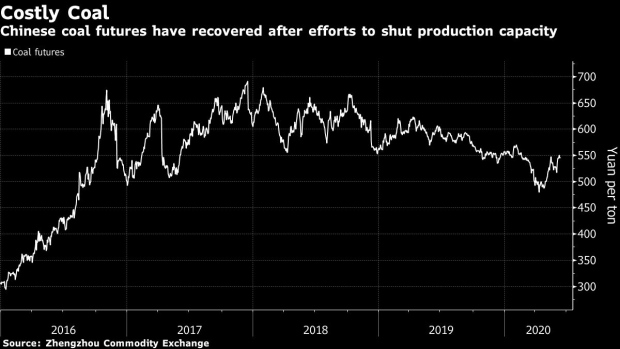Government officials are in the midst of preparing the country’s all-important five-year-plan, the guiding document for policy and industrial development from 2021 to 2025. Unlike the previous edition, when China made a major push to cut overcapacity to support prices and help miners struggling with mounting debt, the government isn’t likely to set any targets for mine closures, analysts forecast.The country in 2016 set a target of shutting 800 million tons of annual capacity, with reductions met two years earlier than planned. To be sure, those mines would essentially be replaced by “advanced” capacity, a term Beijing uses to refer to larger, safer and more-efficient operations.

But the lack of a hard target now would underscore the continuing dependence on coal in China, which mines and burns half the world’s supply. More flexibility for smaller mines would help expand production capacity to meet rising demand as the world’s second-biggest economy continues to dig itself out from the depths of the pandemic.
“We expect the government to continue to manage production capacity,” said Zhai Yu, a senior consultant with Wood Mackenzie Ltd. “But maybe not continue to cut capacity, as we forecast demand increasing in the next five years.”
Analysts at Wood Mackenzie, Daiwa Capital Markets and China Coal Resource are among those who don’t believe China will set a target for closing outdated coal mine capacity in its 14th Five-Year Plan, which will officially be adopted next year.
Total coal production capacity may rise to 5 billion tons a year by 2025, from 4.1 billion currently, according to Daiwa. That will help the country meet demand growth expected from its power sector. China’s thermal coal use will increase and peak in 2026 at about 4.9 billion tons a year, some 11% higher than the current level, Wood Mackenzie’s Zhai said.
Growing coal demand would reverse one of the environmental trends of which Beijing is most proud. World-beating investments in clean energy and a policy-driven shift toward more consumption of cleaner burning natural gas have helped China reduce coal’s share of the energy mix to 57.7% last year, from more than 70% in 2011.
China’s embrace of coal could tighten even further if tensions with the U.S. escalate, forcing policymakers to prioritize energy security over climate change, said analyst Michelle Leung with Bloomberg Intelligence. China could be targeting 1,300 gigawatts of coal-fired capacity in its 14th Five-Year Plan for power, from 1,050 today, she said.
About 46 gigawatts worth of new plants were under construction as of May, already outpacing last year’s total addition, according to a study published by Greenpeace last week. Another 48 gigawatts were under various stages of development as the country lifted curbs on new builds in most regions, it estimated.
“We expect coal to remain the primary source for baseload dispatch, given China’s cheap and plentiful coal reserves,” said Jennifer Song, an analyst with Morningstar. “Coal-fired generation’s reliability and large-scale make it well-suited to meet the country’s power needs.”


